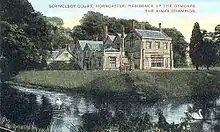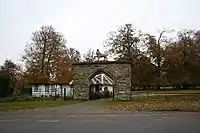Manor of Scrivelsby
The Manor of Scrivelsby, part of Scrivelsby civil parish, is in the East Lindsey district of Lincolnshire, England, 2 miles (3.2 km) south from Horncastle and on the B1183 road 1 mile (1.6 km) east from the A153 road. The population is included in the civil parish of Mareham on the Hill.
| Scrivelsby | |
|---|---|
 Church of St Benedict, Scrivelsby | |
 Scrivelsby Location within Lincolnshire | |
| OS grid reference | TF267659 |
| • London | 120 mi (190 km) S |
| District | |
| Shire county | |
| Region | |
| Country | England |
| Sovereign state | United Kingdom |
| Post town | Horncastle |
| Postcode district | LN9 |
| Police | Lincolnshire |
| Fire | Lincolnshire |
| Ambulance | East Midlands |
| UK Parliament | |
The manor is held by grand serjeanty,[1] a form of tenure which requires the performance of a service rather than a money payment – in this case as the King or Queen's Champion.[1]
History
Scrivelsby appears in the Domesday Book as "Scrivelesbi".[2] It comprised 89 households, 16 villagers, 11 smallholders and 30 freemen, with 8.5 ploughlands, a meadow of 5 acres (0.020 km2), woodland of 100 acres (0.40 km2), a mill and a church. In 1086 lordship of the manor and tenancy-in-chief was transferred to Robert the bursar,[3] alternatively Robert De Spencer,[4] but shortly after the Conquest it was given to Robert Marmion, Lord of Fountenay, on condition that he accept the office of King's Champion.[4] The Marmions had historically been Champions to the Dukes of Normandy and Henry I wanted to reestablish that relationship for his English crown.
The Marmyon (sometimes Marmion) family's time as Champion died out with Philip Marmion, 5th Baron Marmion of Tamworth, who only produced daughters.[4] Joan, the youngest, married Sir Thomas De Ludlow, and it was to her Scrivelsby was left.[4] They had a son, John, who died with no children, and a daughter,[4] or great granddaughter[5] (disputed) Margaret, who married Sir John Dymoke, who in turn became the monarch's champion.[4]
The duty of the King's Champion was to ride armed into the coronation banquet at Westminster Hall and challenge anyone who doubted the new monarch's right to the throne.[5] The Champion then threw down his gauntlet to prove he would fight to the death anyone who did. This was done three times and if no challenge had been made, the king, presented with a gold cup of wine, drank to the Champion, who in turn took the cup, finished the drink, and shouted "Long live your Majesties!".[5] The custom was abandoned after the coronation of George IV in 1821.[5]
Landmarks


The manor house, Scrivelsby Court, was burnt out in 1761,[6] and was demolished between 1955 and 1957.[6] However the gatehouse was retained and restored in 1959.[6] The west front is predominately 15- and 16th-century, with the rest, being Georgian and later.[6] It is a Grade I listed building.[7] The Lion Gateway was built around 1530 and was rebuilt in 1833.[6][8] It is Grade II* listed.[8]
The park was designed by Humphry Repton before 1791. Repton also added two octagonal lodges to the side of the Lion Gate.[9][10]
The church of St Benedict originates from the 13th century, with 15th-century additions. It was completely restored in 1860 by Sir Henry Dymoke (who added a small tower with spire), in greenstone, and in Perpendicular and Early English style. A stained glass east window by Thomas Willement was part of the 1860 rebuild. Within the church is a 1776 chalice by John Swift with an 1805 paten by Samuel and George Whitworth. There are monuments to the Dymoke family and one, c.1300 of a Knight and Lady, probably to the earlier Marmian family.[9][11][12] The churchyard contains a war grave of a Royal Garrison Artillery soldier of World War I.[13]
Today
Today Scriveslby is a country estate with deer park, still under the Dymoke family, and an event site for country fairs. In May 2012 it was announced that the estate would be part of Horncastle's events for the Queen's Diamond Jubilee, with a beacon lit as part of a sequence of National beacons.[14]
See also
References
- John Timbs (1869). Ancestral Stories & Traditions of Great Families Illustrative of English History. Griffifth and Farran. p. 369. Retrieved 23 April 2011.
scrivelsby.
- "Documents Online: Scrivelsby, Lincolnshire", Folio: 339r, Great Domesday Book; The National Archives. Retrieved 22 May 2012
- "Scrivelsby", Domesdaymap.co.uk. Retrieved 22 May 2012
- John Timbs (1869). Ancestral Stories & Traditions of Great Families Illustrative of English History. Griffifth and Farran. p. 376. Retrieved 23 April 2011.
scrivelsby.
- "Horncastle Worthies: Dymokes - Royal Champions". Horncastle Civic Society. Archived from the original on 7 May 2011. Retrieved 23 April 2011.
- Historic England. "Monument No. 352724". PastScape. Retrieved 5 May 2011.
- "Scrivelsby Court, Scrivelsby". British Listed Buildings. Retrieved 5 May 2011.
- "The Lion Gateway, Scrivelsby". British Listed Buildings. Retrieved 5 May 2011.
- Pevsner, Nikolaus; Harris, John; The Buildings of England: Lincolnshire pp. 354-356; Penguin, (1964); revised by Nicholas Antram (1989), Yale University Press. ISBN 0300096208
- "Scrivelsby Court, Lincoln, England: Record Id: 2927"; Department of Archaeology, University of York. Retrieved 22 May 2012
- Cox, J. Charles (1916) Lincolnshire pp. 262-264; Methuen & Co. Ltd.
- Historic England. "Church of St Benedict (1252195)". National Heritage List for England. Retrieved 22 May 2012.
- CWGC Casualty record.
- "Horncastle's official Diamond Jubilee beacon takes shape in Scrivelsby Park"; This is Lincolnshire, 14 May 2012. Retrieved 22 May 2012
External links
- "Horncastle Worthies: Dymokes - Royal Champions"; Horncastle Civic Society. Retrieved 22 May 2012
- "Scrivelsby", Genuki.org.uk. Retrieved 22 May 2012